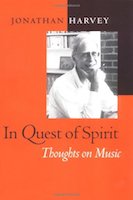The Music of Jonathan Harvey
|
Robert Reigle [April 2000. Originally appeared in La Folia 2:4.]
Concert at Columbia University, New York. November 15, 1999. Performed by Ensemble 21, and electronics created at IRCAM. Jonathan Harvey’s new book/CD In Quest of Spirit (University of California Press) sets forth a sensitive philosophy of the rôle of music in spiritual change. Harvey keeps sounds ever present amongst his words by illustrating each idea with a sound recording or musical notation, a rarity among explanations of music at this profound level. The discussions of ambiguity, unity, stasis, and silence raised my long-standing appreciation of his music to a new level, motivating me to arrange my trip to New York to coincide with this concert and associated discussions. I sat in on a Columbia University composition class where Harvey presented some details regarding tunings and structures of his music, but there was not enough time to fully engage the spiritual bases of compositional choices. Similarly, the pre-concert discussion with Jonathans Harvey and Kramer started to raise some interesting ideas, but would have reached a deeper level as a lecture rather than questions-and-answers. Luckily, I had the opportunity to sit in on Steven Koenig’s interview with Harvey the day before, where the intensity and breadth of insights usually hidden behind his genteel demeanor came forward (see the report in the next La Folia). These insights sounded in the five works heard at the concert. The longest piece, Song Offerings (1985), won the Britten Award in 1993. Scored for soprano and eight instruments, it is a setting of four texts from Tagore’s own translation of his Gitanjali. The instrumental parts glistened at the concert, but the impressive singing did not match the profundity of the texts in some parts. The soprano writing, which emphasizes very high notes as well as the passaggio transitional range, requires non-standard techniques of vibrato. Judith Bettina seemed to sacrifice details of vibrato (specified in the score) in favor of emotional projection (as didPenelope Walmsley-Clark in the Nimbus recording). Tombeau de Messiaen (1994), for piano and DAT tape, received a spirited performance by pianist Marilyn Nonken. The work blends the live (equal-tempered) piano with pre-recorded piano sounds tuned to twelve different harmonic series. Harvey works with the ambiguity of the two tunings through skillful transitions and overlapping. If I understand correctly, he sees ambiguity as a way of spiritually transcending duality. Hearing the tape piece Mortuos Plango, Vivos Voco (1980) in the hallowed halls of Miller Theatre brought memories of Varèse’s Deserts, which I heard there in the 1980’s. Harvey’s piece incorporates micro-details of sound that Varese did not have access to. Mortuos blends his son’s voice with bell tones, exploring ambiguity in a different way than in the piano work. It sounded beautiful in that small-sized auditorium. Nataraja (1983), for flue and piano, concerns the four-armed Shiva as dancer. The music portrays the flickering flames that encircle Shiva. Flutist David Fedele and pianist Marilyn Nonken played the virtuosic music with passion. A lighter piece, The Riot (1993), closed the first set. The wonderful Jean Kopperud brought out the complex fun of the bass clarinet part, supported by equally vivacious flute and piano playing. Heard in one sitting, the five works allowed one to experience the ambiguity and spiritual searching Jonathan Harvey aims for. An excellent concert. With four books published in 1999 by and about Jonathan Harvey, I hope that we will not have to wait too long to hear his orchestral works and opera here in the colonies.
[More Robert Reigle, Vol. 2, No. 4]
[More
Harvey]
[Previous Article:
Notes on Schnittke]
[Next Article:
Three Reviews]
|
